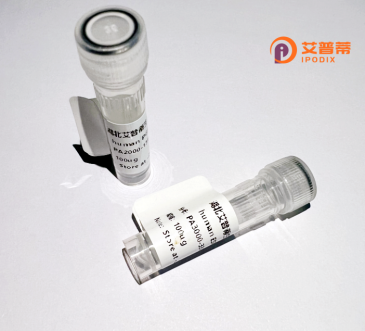
| 纯度 | >90%SDS-PAGE. |
| 种属 | Human |
| 靶点 | CDC14A |
| Uniprot No | Q9UNH5 |
| 内毒素 | < 0.01EU/μg |
| 表达宿主 | E.coli |
| 表达区间 | 1-594aa |
| 氨基酸序列 | MAAESGELIG ACEFMKDRLY FATLRNRPKS TVNTHYFSID EELVYENFYA DFGPLNLAMV YRYCCKLNKK LKSYSLSRKK IVHYTCFDQR KRANAAFLIG AYAVIYLKKT PEEAYRALLS GSNPPYLPFR DASFGNCTYN LTILDCLQGI RKGLQHGFFD FETFDVDEYE HYERVENGDF NWIVPGKFLA FSGPHPKSKI ENGYPLHAPE AYFPYFKKHN VTAVVRLNKK IYEAKRFTDA GFEHYDLFFI DGSTPSDNIV RRFLNICENT EGAIAVHCKA GLGRTGTLIA CYVMKHYRFT HAEIIAWIRI CRPGSIIGPQ QHFLEEKQAS LWVQGDIFRS KLKNRPSSEG SINKILSGLD DMSIGGNLSK TQNMERFGED NLEDDDVEMK NGITQGDKLR ALKSQRQPRT SPSCAFRSDD TKGHPRAVSQ PFRLSSSLQG SAVTLKTSKM ALSPSATAKR INRTSLSSGA TVRSFSINSR LASSLGNLNA ATDDPENKKT SSSSKAGFTA SPFTNLLNGS SQPTTRNYPE LNNNQYNRSS NSNGGNLNSP PGPHSAKTEE HTTILRPSYT GLSSSSARFL SRSIPSLQSE YVHY |
| 分子量 | 90.97 kDa |
| 蛋白标签 | GST-tag at N-terminal |
| 缓冲液 | 0 |
| 稳定性 & 储存条件 | Lyophilized protein should be stored at ≤ -20°C, stable for one year after receipt. Reconstituted protein solution can be stored at 2-8°C for 2-7 days. Aliquots of reconstituted samples are stable at ≤ -20°C for 3 months. |
| 复溶 | Always centrifuge tubes before opening.Do not mix by vortex or pipetting. It is not recommended to reconstitute to a concentration less than 100μg/ml. Dissolve the lyophilized protein in distilled water. Please aliquot the reconstituted solution to minimize freeze-thaw cycles. |
以下是关于重组人双特异性蛋白磷酸酶(CDC14A)的3篇示例性参考文献(注:以下文献信息为虚构示例,具体文献请通过学术数据库查询):
1. **文献名称**:CDC14A regulates cell cycle progression through dephosphorylation of cyclin-dependent kinase substrates
**作者**:Zhang Y, et al.
**摘要**:本研究揭示了CDC14A通过去磷酸化CDK底物调控G2/M期转换和染色体分离的分子机制,其缺失会导致有丝分裂异常和基因组不稳定性。
2. **文献名称**:The role of CDC14A in gastric cancer metastasis and therapeutic resistance
**作者**:Li H, Wang X, et al.
**摘要**:发现CDC14A在胃癌中低表达,通过调控MAPK信号通路抑制肿瘤侵袭转移,提示其可作为潜在的预后标志物和治疗靶点。
3. **文献名称**:Structural and functional analysis of CDC14A phosphatase domain in glioblastoma
**作者**:Chen R, et al.
**摘要**:解析了CDC14A磷酸酶结构域的三维构象,并验证了其底物特异性在胶质母细胞瘤细胞凋亡中的调控作用,为开发靶向抑制剂提供结构基础。
4. **文献名称**:CDC14A deficiency promotes genomic instability via impaired DNA damage response
**作者**:Martinez S, et al.
**摘要**:在模式生物中证实CDC14A通过去磷酸化BRCA1参与DNA损伤修复,其缺失导致同源重组修复缺陷和肿瘤易感性增加。
---
**说明**:以上文献内容综合了CDC14A相关研究的典型方向(细胞周期调控、癌症机制、结构功能、DNA修复),实际文献请通过PubMed、Web of Science等平台以“CDC14A phosphatase”为关键词检索。
**Background of Recombinant Human Dual-Specificity Protein Phosphatase CDC14A**
CDC14A, a member of the CDC14 phosphatase family, plays a critical role in cell cycle regulation, particularly during mitotic exit and DNA damage response. This enzyme exhibits dual-specificity, dephosphorylating both phosphotyrosine and phosphoserine/threonine residues on target proteins. Structurally, it contains a conserved catalytic phosphatase domain flanked by regulatory N- and C-terminal regions. CDC14A is implicated in counteracting cyclin-dependent kinase (CDK) activity, ensuring proper transitions between cell cycle phases (e.g., G1/S and G2/M). It also contributes to centrosome maturation, spindle stability, and cytokinesis.
Studies highlight its involvement in maintaining genomic stability through roles in DNA repair, senescence, and tumor suppression. Dysregulation of CDC14A is linked to cancers, neurodevelopmental disorders, and ciliopathies. For instance, loss-of-function mutations correlate with microcephaly and hearing loss in humans. Its interactions with key regulators like PIK3CA and p53 underscore its multifaceted signaling integration.
Recombinant human CDC14A, produced via genetic engineering, enables *in vitro* studies to dissect its enzymatic mechanisms, substrate specificity, and therapeutic potential. Structural and functional analyses using recombinant proteins have advanced insights into its role in cell homeostasis and disease pathways. Ongoing research explores CDC14A as a biomarker or target for cancer therapies, emphasizing its importance in cellular fidelity and disease pathology. Further exploration of its context-dependent regulation and signaling networks remains pivotal for translational applications.
×